There are 7 main ways to avoid a soggy, undercooked pizza:
All of these are factors that will affect how crisp your homemade pizza turns out. The best pizzas are typically crispy, and definitely not soggy or undercooked.
Shop bought pizzas are already pre-cooked and are made to be cooked at low temperatures. Whilst they may be easy and convenient, they do not come close to a delicious homemade pizza.
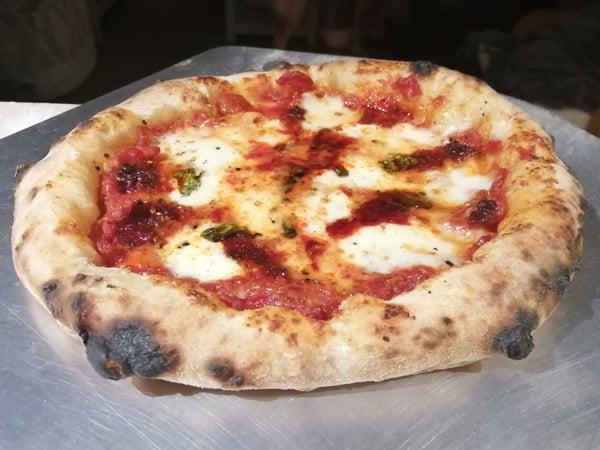
Homemade pizza will take a bit of time to master, but it really isn’t that difficult. If you follow my advice you’ll be at least half way there. And trust me, you’ll love homemade pizza!
Cooking homemade pizza at too low a temperature is an all too common mistake. It’s the number 1 cause of a soggy pizza but fortunately, it’s an easy fix.
As well as cooking your pizza at the correct temperature, don’t forget to preheat your oven for at least 30 minutes!
Click here to find out everything you need to know about the perfect temperature for a home oven.
If you don’t stretch your pizza out so that it is very thin, it is difficult to cook the top of the pizza base.
Usually, with a domestic oven, the bottom of the pizza cooks quite nicely but it is difficult to cook the top. This is because, unlike a pizza oven, there are no flames to cook the top of the pizza.
In a traditional wood fired oven, the pizza stone or cooking surface gets incredibly hot which cooks the base but there are also flames that cook the top of the pizza.
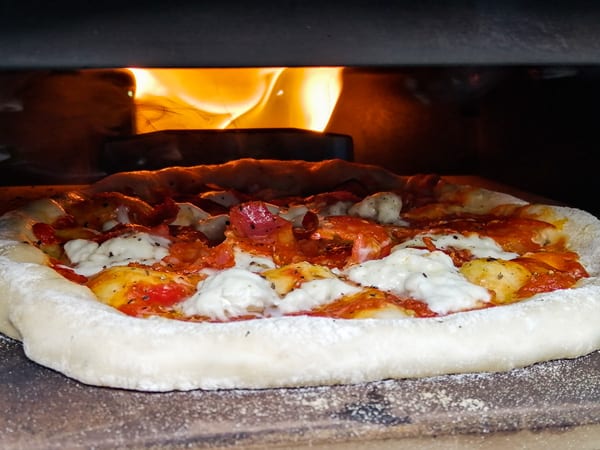
If the pizza is too thick you will generally find that the base cooks OK but the top will be very soggy and undercooked.
This is something that takes a bit if experience to learn but I can give you some pointers to help you along.
Generally, you should be able to stretch your dough out so thin that you can see through it. In fact, this is a great way to tell of your dough is stretched out evenly.
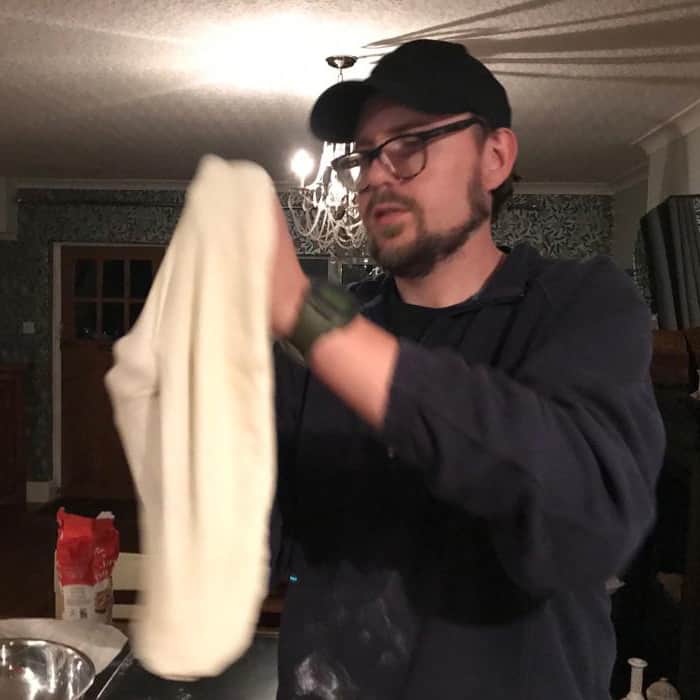
As you hold your pizza up to the light, you should be able to stretch it out so thin that light passes through it. If there are areas of the pizza where light doesn’t pass through, you can stretch the pizza out in these areas.
There are many different techniques for stretching out pizza and there isn’t one correct method. I’ll be bringing out an article soon about stretching techniques and tips.
The most important factor in being able to achieve a thin pizza is the quality of your dough. If your dough is not very good, it will rip before it gets thin enough.
Click here to check out my no knead pizza dough if you are new to making pizza dough.
If you’ve made dough before then you may want to jump straight into a more authentic Neapolitan recipe.
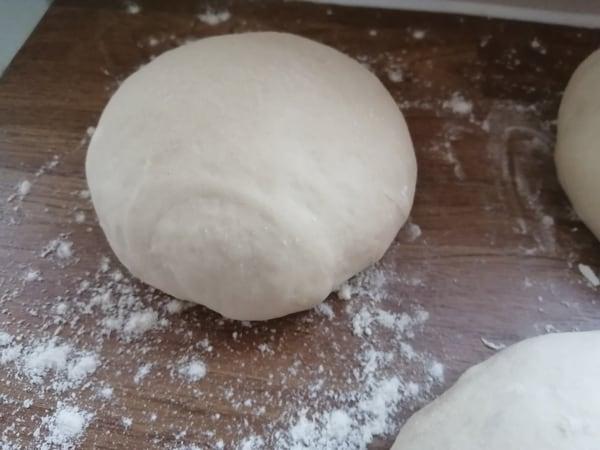
Achieving this quality of dough takes some practice but it’s not as difficult as you think.
When making the dough you should aim for these 2 characteristics:
If we can achieve these two things, we can be pretty sure that our dough will be able to stretch out really thin, which will help it to cook properly.
Using a pizza stone or pizza steel to cook your pizza on will increase the temperature and improve the overall cook. If you don’t have a pizza stone or steel you can use a regular baking tray.
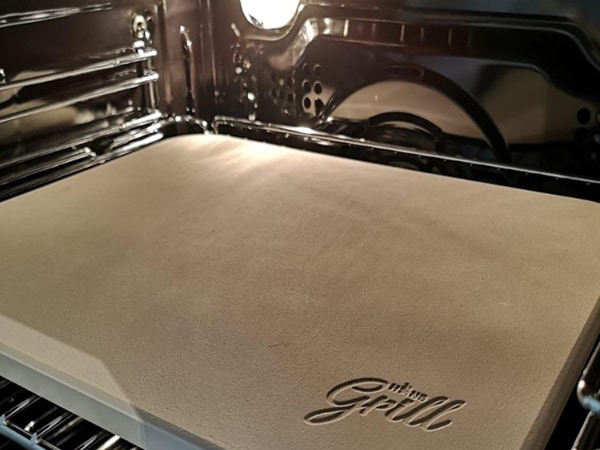
A thick cordierite pizza stone is an excellent option.
Cordierite pizza stones are slightly more expensive than ceramic ones. However, cordierite is more durable better at retaining heat. Having had a ceramic pizza stone break on me before, I can recommend using a cordierite stone.
If you don’t have a pizza stone then you can just use a regular baking tray. My best advice is to turn the tray upside down which will work just as well, if not better, and will make it easy for you to get the pizza on and off the tray.
A baking tray will work just fine, as long as it is large enough to fit a 10 inch pizza on.
If your tomato sauce is too watery, this will make the dough moist which will turn soggy as it cooks.
It is important that your sauce is quite thick. This is especially true of pizzas cooked in a domestic oven where temperatures don’t reach above 300 degrees.
There are many different ways to make tomato sauce for pizza but the two main types are cooked and uncooked.
I will explain the basic principles for each type of tomato sauce below.
For a cooked sauce, the easiest way to thicken the sauce is to simply heat it up until it reaches the desired thickness. This will evaporate off some moisture, leaving you with a perfect consistency. If the sauce becomes too thick, you can simply add a dash of water.
Be sure to season the sauce with salt and pepper to taste. Other ingredients such as garlic and basil are optional.
Because the sauce cooks on the pizza, the sauce doesn’t need to be cooked first. In fact, the traditional Italian recipe calls for an uncooked sauce. When using an uncooked sauce be sure to sieve the tomatoes to remove excess water.
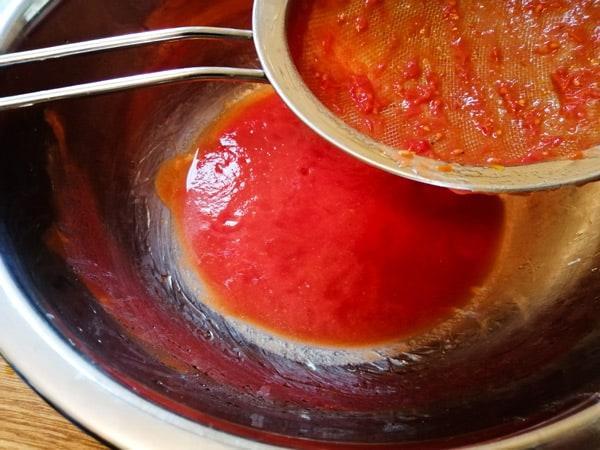
Describing the perfect consistency is tricky and it will depend somewhat on how your oven cooks pizza. In general, I would say to aim for a thick soup or thick pasta sauce consistency.
Don;t forget to season the sauce with salt and pepper to taste. That is the most simple yet authentic pizza sauce! If you like, you can also add some sliced garlic and some basil leaves.
This is often overlooked but fresh mozzarella comes in a brine solution. As such, it contains quite a lot of moisture.
If left as it is, the water will come out of the mozzarella as it cooks and it will leave the dough soggy. Removing most of the moisture, however, is super easy.
The easiest way is to simply tear or cut the mozzarella ball into small pieces and wrap in kitchen roll. You can leave it like this for an hour or so and it will remove a great deal of moisture.
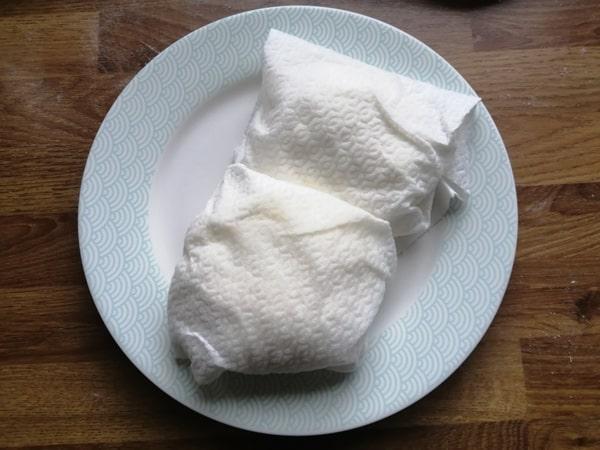
If you don’t have that long, simple squeeze as much water as you can out and then pat dry with kitchen roll. You can then use your mozzarella as normal and it will help your pizza to cook much better.
I like to remove as much moisture as I can and then slice the mozzarella using a sharp knife. I then wrap the slices in kitchen roll and leave in the fridge for an hour or so to dry.
The temptation for many people making homemade pizza is to add loads of toppings. However, too many toppings prevent the pizza dough from cooking properly.

Adding lots of sauce and cheese will not only increase the amount of moisture but it will also form a thick barrier on top of the dough. This barrier will prevent the heat from getting to the dough, which will lead to soggy undercooked pizza.
Avoid adding too many of toppings that contain a lot of moisture or oil. Toppings like salami, particularly Nduja, contain a lot of oil so be careful. If you do use oily toppings reduce the amount of olive oil you use.
Nduja is one of my favourite pizza toppings. Incredible meaty, spicy, oily goodness that coats your mouth! It’s a traditional spreadable salami from Italy that is difficult to get hold of.
Fortunately, it’s easy to get hold of on Amazon!
In summary, there’s a reason why traditional Italian pizzas don’t have many toppings on them! Try not to overdo it.
Click here to find out about the best, most authentic Italian, Neapolitan toppings.
I personally love olive oil on pizza. As well as adding a wonderful taste, it also adds some moisture and prevents the pizza from being too dry.
However, if too much is added it will prevent the dough from cooking properly. This is especially true in domestic ovens where temperatures are lower.
My best advice is to cook the pizza in your domestic oven without olive oil and then add it afterwards to taste. I also like sprinkling it on the crusts!
If you have tried all the above and you are still finding your pizza is a little undercooked or soggy, this method may work wonders:
This technique works well in domestic ovens where temperatures are much lower than pizza ovens. It ensures that the pizza base is already partly cooked before the toppings get added.
Don’t forget to time your pizza and cook it for the normal amount of time. Do not cook it for an additional 1 – 2 minutes without the toppings, this time should be part of the normal cooking time.
Click here for more information on cooking times.
Check out this recipe on stellaculinary.com for a New York style pizza that is designed specifically for home ovens.
The most important steps to avoid an undercooked soggy pizza are to cook at the correct temperature, stretch your pizza out very thin, and use a pizza stone or baking tray. Also, reduce the moisture in your wet ingredients and use less of them. Be sure to try out the bonus tip if needs be.
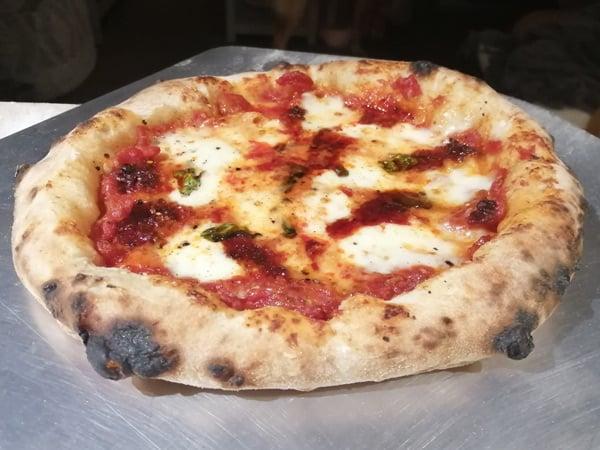
Hopefully this has solved your soggy, undercooked pizza or got you very close. Pizza is not as hard to make as most people think but it does take some trial and error. Don’t give in if your pizza is not there yet, it will be worth it trust me!

I’m Tom Rothwell and I’m super passionate about all kinds of homemade pizza! In the last few years I've been on a quest to find the perfect pizza. Now I'm sharing what I've found out with the world!

If you're interested in hiring me for your event in the UK, feel free to check out my website with the link below.
Pizza Catering
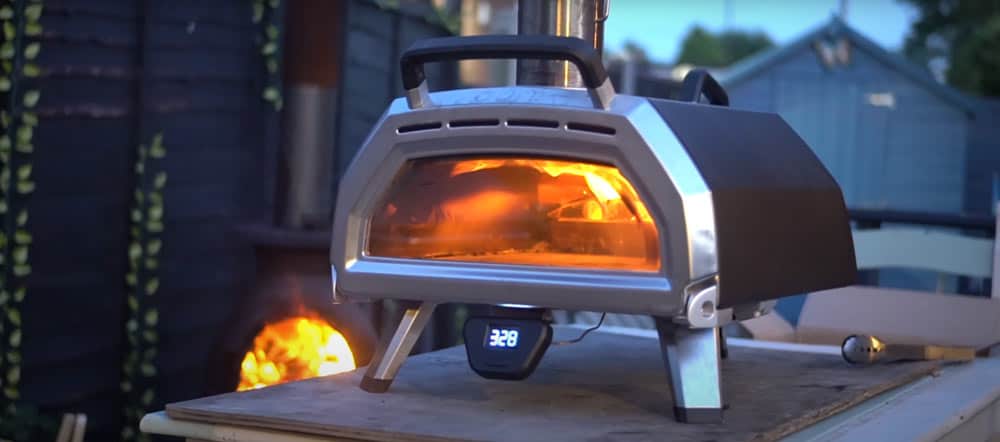
I often get asked what type of oven I use for my pizzas. Well, I use a pizza oven made by a company called Ooni.
The range of pizza ovens that Ooni offers is just brilliant. They cover all bases, and all price points. There's affordable and portable models such as the Fyra 12 Pizza Oven and then there's state-of-the-art models such as the Karu 16 Pizza Oven pictured below.
In all honesty, I would say that the oven makes a huge difference. If you're looking to make authentic Italian pizza, a pizza oven is a must.
By clicking the link below and purchasing from Ooni, you would be supporting this website. I've been using their ovens for a long time now and I wouldn't recommend them if I didn't believe in their products.
Time to make some amazing pizza!

I’m Tom Rothwell and I’m super passionate about all kinds of homemade pizza! In the last few years I've been on a quest to find the perfect pizza. Now I'm sharing what I've found out with the world!

If you're interested in hiring me for your event in the UK, feel free to check out my website with the link below.
Pizza Catering
Excellent tips thank you. Onwards and upwards
Regards
Soggy Bottom
We have been trying to perfect our pizza for years. We have just bought an Ooni. We tried it last night and overall much better that conventional oven but what temp do you have yours at for perfect cooking
Hi Helen, yes a pizza oven is essential for Neapolitan style pizza! I recommend a stone temperature of between 430-460C (800-860F) – a laser thermometer is ideal for measuring this.
A temperature lower than this range usually results in a pizza that is too crispy for Neapolitan. A temperature above this range can easily lead to burning. Hope this helps. Good luck!
I am Pizza obsessed and relatively experienced. I was browsing today and came across your your YouTube vids and started to watch. Although it was all familiar to me, I wanted to compliment you for pulling it all together. You have a nice simplified style which would be easily digestible, especially to people just starting out. I then browsed through your website ..again a good job.
I will make pizza on Wed, dough is already in fridge proofing. I usually do a 24 hour proof but this week its 36!
Awesome, thanks the positive feedback Jim! It’s nice to hear that my content is appreciated. Keep up with the delicious pizzas!